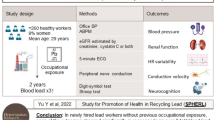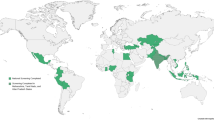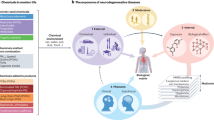Abstract
LEAD-CONTAINING organic compounds such as tetraethyl and tetramethyl lead have been used for over 50 years as anti-knock additives to petrol. The occupational hazards associated with their production and use are well documented, but no adverse effects of environmental pollution by organolead compounds have yet been demonstrated. Here we present an analysis of 22 human brains which shows that a significant part of the lead content may be organolead. The highest concentrations (median, 2 × 10−7 mol per kg) were present in individuals residing in the lower floors of buildings in the city.
This is a preview of subscription content, access via your institution
Access options
Subscribe to this journal
Receive 51 print issues and online access
$199.00 per year
only $3.90 per issue
Buy this article
- Purchase on Springer Link
- Instant access to full article PDF
Prices may be subject to local taxes which are calculated during checkout
Similar content being viewed by others
References
Laveskog, A. Proc. 2nd Int. Clean Air Congr. 549–557 (1971).
Purdue, L. J., Enrione, R. E., Thompson, R. J. & Bonfield, B. A. Analyt. Chem. 45, 527–530 (1973).
Harrison, R. M. & Laxen, D. P. H. Atmos. Environ. 11, 201–203 (1977).
Publ. Hlth. Serv. Publs. Wash. No. 999-AP-12, 2nd Printing (1970).
Lead, Airborne Lead in Perspective (National Academy of Science, Washington, D.C., 1972).
Cutchis, P. Science 184, 13–19 (1974).
Clouston, J. G. & Cook, C. L. Trans. Faraday Soc. 54, 1001–1007 (1958).
Prileshajeva, N. & Terenin, A. Trans. Faraday Soc. 31, 1483–1487 (1935).
Laug, E. P. & Kunze, F. M. J. Ind. Hyg. Toxicol. 30, 256–259 (1948).
Hayakawa, K. Jap. J. Hyg. 26, 377–385 (1971); 26, 526–534 (1972).
Bolanowska, W., Piotrowski, J. & Garczynski, H. Archs Tox. 22, 278–282 (1967).
Grandjean, P., Fjerdingstad, E. & Nielsen, O. V. Proc. Int. Conf. Heavy Metals in the Environment, Toronto, 1975 (in the press).
Niklowitz, W. J. & Yeager, D. W. Life Sci. 13, 897–905 (1973).
Niklowitz, W. J. Neurotoxicology 1, 289–298 (1977).
Cassels, D. A. K. & Dodds, E. C. Br. med. J. 2, 681–685 (1946).
Henry, R. A. & Byington, K. H. Biochem. Pharmac. 25, 2291–2295 (1976).
Galzigna, L., Corsi, G. C., Saia, B. & Rizzoli, A. A. Clin. chim. Acta 26, 391–393 (1969).
Skilleter, D. N. Biochem. J. 146, 465–471 (1975).
Aldridge, W. N., Cremer, J. E. & Threlfall, C. J. Biochem. Pharmac. 11, 835–846 (1962).
Author information
Authors and Affiliations
Rights and permissions
About this article
Cite this article
NIELSEN, T., JENSEN, K. & GRANDJEAN, P. Organic lead in normal human brains. Nature 274, 602–603 (1978). https://doi.org/10.1038/274602a0
Received:
Accepted:
Issue Date:
DOI: https://doi.org/10.1038/274602a0
This article is cited by
-
Direct determination of lead in wine materials by atomic absorption spectrometry using an electrothermal atomizer with a graphite filter-insert
Journal of Applied Spectroscopy (2013)
-
The effects of triethyl lead on the development of hippocampal neurons in culture
Cell Biology and Toxicology (1995)
-
Developmental exposure to organic lead causes permanent hippocampal damage in Fischer-344 rats
Experientia (1990)
-
Triethyl lead induced rearrangement of fatty acids in the triacylglycerol- and phospholipid-fractions of HL-60 cells as measured by HPLC
Fresenius' Zeitschrift für analytische Chemie (1988)
-
Organic lead and histological parameters of brain development
Acta Neuropathologica (1984)
Comments
By submitting a comment you agree to abide by our Terms and Community Guidelines. If you find something abusive or that does not comply with our terms or guidelines please flag it as inappropriate.



